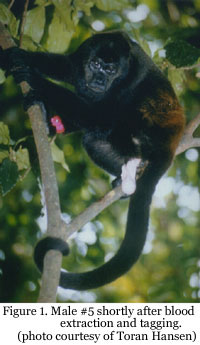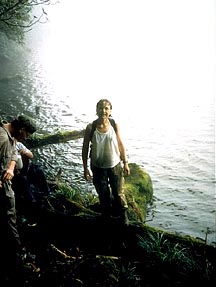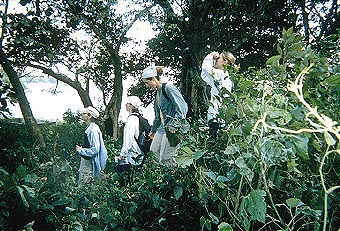


Summer 2000: May 25 - June 19, 2000
This is designed to be a field course which explores the interfaces between primate behavior and biology. The field site will serve as a living laboratory where students experience New World monkeys, their biology and behavior, in their native habitats. The course is comprised of daily lectures and daily field exercises on aspects of primate ecology, biology, behavior, and the rainforest environment. Howler monkeys and possibly capuchins will be observed on a daily basis in forest environments surrounding the field station. All students will develop research proposals which will be done on site during the latter half of the course.
Lecture topics in the course will include:
1. Richard, Allison, Primates in Nature. W.H. Freeman and Co., Salt Lake City, Utah 84104 (ISBN No. 071671647X)
These texts can be ordered from your local college bookstore. Please be advised that it may take 3-4 weeks for the books to be received. Do not wait until the last minute to order. We recommend that you familiarize yourself with the material in these books before you leave for Nicaragua. It will help in preparing for the lecture and exams.
As mentioned, Ometepe maintains a small library of journal articles and texts. Each student IS REQUIRED to bring to Ometepe two scientific articles on some aspect of primate behavior, ecology, conservation, or rainforest ecosystems. We ask that you donate these to our field library.
Photo thanks to Toran Hansen
I developed this course as a result of my own interests in primate biology, ecology and conservation. I have begun a project at the field site on howler monkey demographics in which I am presently assessing the genetics and health status of the howling monkeys. My collaborators and I did a capture and release project involving the howling monkeys at Ometepe in July of 1998. We tagged, did physical examinations, and took samples from most of the adults in one troop near the field station. I am analyzing these samples for DNA in the hope of establishing paternity within the howler troops, assessing homozygosity, and allow the Estacion Biologica Ometepe to monitor population size and the movement of young animals (all groups are breeding and producing young) in the environments surrounding the field sites.
Additional skills taught in the field course include:
Independentf Research Projects: Each student will work with the faculty in designing and completing independent research project. Students will present their ideas for projects to the entire class during the second week of the course and shortly thereafter begin their independent research. In the final week of the course, each student will present their final report orally to the class. Possible topics include:
General Course Schedule
(Length and activities may vary.)
 Day 1: (or day before) Arrive in Managua, Nicaragua. Go by bus to Granada for the night. Get settled and acquainted-extensive orientation-brief tour of facilities. If you come in the day before you will need to stay overnight in Managua or in Granada. We will make arrangements for rooms where the instructors are staying. You will need to budget about $25 for a room.
Day 1: (or day before) Arrive in Managua, Nicaragua. Go by bus to Granada for the night. Get settled and acquainted-extensive orientation-brief tour of facilities. If you come in the day before you will need to stay overnight in Managua or in Granada. We will make arrangements for rooms where the instructors are staying. You will need to budget about $25 for a room.
Day 2: Off to Ometepe and the field site. Tour of facilities, orientation, and break up into small groups to learn trail system, use of compass, and begin plant and animal observations in the forest. Daily lectures begin.
Day 3-2: Faculty will divide students into groups of 4-6. Each group will spend two days learning about and working on:
Day 13: Completion of Research Proposal for Independent Research Project
Day 13: Examination
Day 13-22: Collect and analyze data for independent field project.
Day 22: Meet with Faculty and write-up Independent research projects.
Day 23: Oral presentation of independetn field projects.
Day 24-25: Farewell fiesta, leave for Granada, stop and see some of Nicaragua along the way. You will spend two nights in Granada.
Students from the last two summer's Primate Behavior and Biology classes have put together a website of pictures from their experiences. You can visit this website at:
http://ucsu.Colorado.EDU/~salzbery/
http://www.geocities.com/Area51/Lair/9505/
Faculty: Dr. Linda Winkler - University of Pittsburgh
Grading: The course is divided into two components:
Grading for the field techniques will be based on:
Participation and completion of field exercises: 25%
Mastery of techniques during field technique rotations: 15%
Score on exam given on field techniques: 25%
Cooperation and ability to work with others: 10%
Mid-term exam: 25%
Grading for the lecture-research component will be based on:
Research article presentation: 10%
Writing the research proposal: 25%
Collecting data (doing the research): 25%
Project: 20%
Report: 20%
Lecture/Research Design (throughout the course)
There will be lectures or presentations scheduled every day from 4-5:30 PM, except the day of the midterm (June 7). We will also meet after supper every day to discuss our daily adventures, research projects, etc.
Lecture topics and readings include:
| May 25-26 | Introduction to primates (Primates in Nature pp. 1-39) |
| May 27-28 | What is a primate? (Primates in Nature pp. 40-123) |
| May 29-30 | What do primates look like (inside and out)? (Primates in Nature pp. 206-230) |
| May 31 | Primate diets (Primates in Nature pp. 125-205) |
| June 1 | Life history and demography (Primates in Nature pp. 233-288) |
| June 2-3 | Primate social organization (Primates in Nature pp. 290-341) |
| June 4 | Primate adaptations (Primates in Nature pp 342-379) |
| June 5 | Proposals due for research project. Review |
| June 6 | Exam, Begin projects |
| June 7 | Primates and plants (Primates in Nature pp. 427-463) |
| June 8 | A look at local monkey species |
| June 9 | Parasites |
| June 10 | (Call your airline to reconfirm seat.) |
| June 10-14 | Presentations from faculty (DNA analysis, etc.) Student will be doing independent research projects. |
| June 15 | Each student must hand in their completed research report by 6:00 PM. See below for description of what must be included. |
| June 16 | Oral presentations of research reports beginning at 8:00 am (see below). Pack and prepare to leave (very sad ) |
| June 17-18 | Good-bye wonderful jungle and monkeys. Good-bye Ometepe. Off to see more of Nicaragua before heading home.. |
Research projects and reports
The thought of doing a research project can seem very overwhelming. However, we will help you develop your ideas and the project while you are in the course. Some of you already have ideas about what you want to do, and all of you will think of many more once you are there.
Your research proposal (Due June 5 - we will have a party after they are all in) should include:
OBJECTIVES AND SIGNIFICANCE (What do you want to accomplish and what
is its significance?)
BACKGROUND (What types of research have other people done?)
RESEARCH QUESTIONS (HYPOTHESES) (What specific questions or
hypotheses are you going to test?)
METHODS (Identify the specific data collection techniques, which you are
going to use.)
SUMMARY
In addition, you should include descriptions and detailed definitions of the behavioral, biological variables, which you will be studying in your proposal. This can be put in an appendix, figure, or table.
Research projects have to be approved by me before you begin your project.
The research reports (Due June 15) should include:
ABSTRACT (Summary)
INTRODUCTION (brief background and indicating research question)
METHODS (be concise and give detail)
RESULTS (present your data)
DISCUSSION (talk about your results in comparison to other research and issues)
CONCLUSIONS (list at least four conclusions)
REFERENCES, TABLES, FIGURES
We have a small library at Ometepe and you are welcome to use the reprints and books there for your projects and reports.
Oral Presentations
We will begin oral presentations at 8:00 am. Each student will have 15 minutes for presentation of their research results and 5 minutes for discussion. You can use note cards or an outline to help you.
Field trips
The class will do at least one day trip on Ometepe during the course. The previous classes have chosen to hike to the crater lake at the top of the Volcano Maderas. In addition, we will spend the last two days in the area around Granada, seeing some of southern Nicaragua. Granada is a beautiful Spanish colonial city founded by the conquistadors in 1524. It is a short ride from there to Masaya where we can see (and buy) hammocks being made and visit the large craft market.
For information on the Primate Behavior and Biology, please contact:
